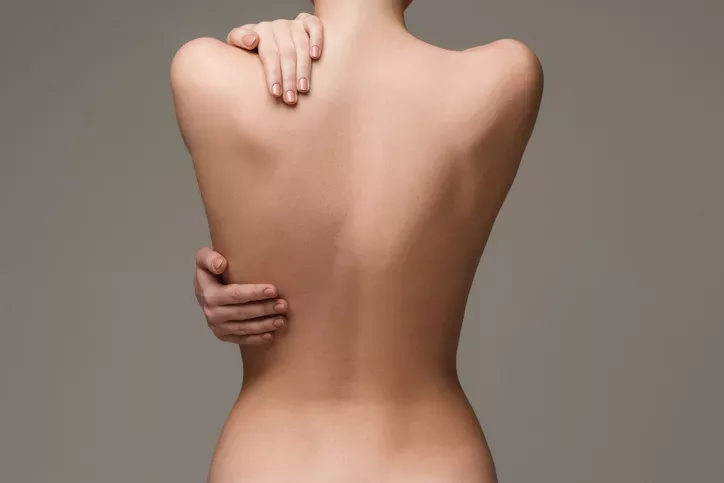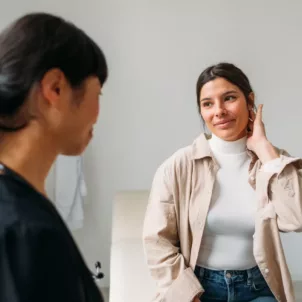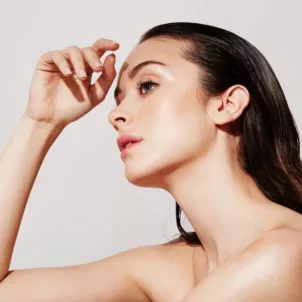Nipple hair is common, but it’s often an embarrassing issue. Discover what hairy nipples might be able to tell you about your health, plus how to not let this ultra-common situation crush your self-confidence.
In the past decade, thanks to the interconnection allowed by social media and empowerment by women and genderqueer folks like Shari Siadat and Queen Esie, a growing population of people have started embracing body hair around their eyebrows, bikini line, legs and underarms.
But how about nipple hair? For some reason, this one particular area still feels taboo. Back in early 2019, now 38-year-old singer Lily Allen sparked a quiet but global conversation when she posted a selfie of herself getting ready for an awards show.

“Georgie [her makeup artist] is literally plucking hairs out of my nipples and I didn’t even know they were there,” the 33-year-old told her hundreds of thousands of Instagram followers, while changing from a black Coach dress to a flesh-colored leotard. “Because I obviously haven’t looked at my nipples in so long,” Refinery29 UK reports.
This honest share drew comments and news stories on both sides, and sparked a long overdue international conversation about the topic of nipple hair. While fuzzy armpits, bikini wax breaks and beyond-winter hairy legs are becoming more common amidst growing body neutrality conversations, nipple hair among women still seems to carry some stigma. Publications like the UK tabloid The Sun declaring it “an awkward and embarrassing problem,” certainly aren’t helping.
So we’re here to set the record straight. If you have nipple hair, no, you’re not alone. You’re not “weird.” And you don’t even need to give a pluck if you don’t want to. But you might want to tune in if other symptoms arise.
Ahead, discover the potential causes of nipple hair, how to manage it (if you want to), other conditions that nipple hair might be able to clue you in about and how to embrace yourself and your strands—no matter where they pop up.
The Causes of Nipple Hair
Humans are born with more than 5 million skin follicles that produce hair naturally all over the body, including occasionally on the nipples. Nipple hair is often fine and pale, so some women barely or never notice it. Other times, it can be dark, coarse and more visible. Nipple hair can also change throughout the lifespan and may become more noticeable with age.
If you observe a substantial shift in the amount, color or texture of nipple hair, it could be due to:
- Hormones. Testosterone is a hormone that’s produced in human testes and ovaries and is involved with libido, muscle strength, hair growth and more. Men tend to have more testosterone than women, but folks on any range of the gender spectrum pump out testosterone. Women who have more testosterone than “normal” can experience a hormonal imbalance that can result in an overproduction of male-pattern body hair called hirsutism. In addition, the hormonal roller coaster that occurs during pregnancy and menopause—while natural—can also lead to more or darker nipple hair. (Did you know hormones play a role in mental health, too?)
- Polycystic ovarian syndrome (PCOS). Hormonal imbalances, including the overproduction of testosterone, can also play a role in the development of PCOS. (High levels of insulin is believed to cause some cases of PCOS as well.) About 10 percent of women of childbearing age have PCOS, a condition that can result in excess hair growth, irregular periods, infertility and ovarian cysts.
- Medications. Glucocorticosteroids, corticosteroids or anabolic steroids (to treat inflammation or asthma), Danazol (for endometriosis), phenytoin (to prevent seizures), interferon (for hepatitis C), dehydroepiandrosterone (DHEA) (to promote the production of estrogen and testosterone), minoxidil (for hair growth) and some immunosuppressants may cause excess hair growth around the body, including nipple hair.
- Cushing’s syndrome. When the adrenal glands pump out too much of the stress hormone cortisol—and when that cortisol cycles throughout the body long-term—humans can develop Cushing’s syndrome. (Prolonged use of prescribed glucocorticosteroid and tumors in certain adrenal glands can also lead to Cushing’s syndrome.)
(Your doctor can help determine if one of these is the root cause via blood tests and other lab tests.)
How to Manage Nipple Hair
You have our full permission to channel your inner queen of confidence and embrace your body hair—nipples, armpits or otherwise—but if you prefer to remove it, you have a few options.
- Trimming. Use a pair of sharp scissors (extra fine nail scissors work well here) to carefully cut off nipple hair near the follicle (without hitting or breaking the skin).
- Tweezing. Use a pair of tweezers to pluck the hair at the root.
- Shaving. While in the shower, lift and hold skin taut, add shaving cream and use a clean razor to carefully trim the hair.
- Waxing. Since this is a more invasive process, it’s best done at a salon.
- Electrolysis and laser hair removal. For these in-office procedures, a professional inserts a small wire (electrolysis) or shoots a strong laser (laser hair removal) into the follicle. That wire produces an electric current that damages the follicle. With repeated administration, this can cause hair to stop growing back in that area. While often effective, each session can cost about $300 and the process can be uncomfortable for those with sensitive skin.
- Hormonal treatment. Single hormone medications or multi-hormone birth control pills can be used to steady the hormonal seesaw (which may, in turn, tame excess hair growth).
Some individuals turn to hair removal creams and bleach for patches around the bikini line, legs or armpits, but avoid using these around the nipple area since the region tends to be more sensitive.
The Bottom Line
Celebrity or not, our bodies have millions of hair follicles top to bottom—literally—so nipple hair is totally normal and nothing you need to “manage” unless you want to. That said, any sudden changes in nipple hair thickness, color or quantity could be your body’s way of alerting you to a larger underlying problem. Check in with your medical provider if you witness noticeable shifts; they should be able to help you find answers to any potential cause (or ease your mind and tell you that you’re A-OK to move on).









